GD Star Rating
loading...
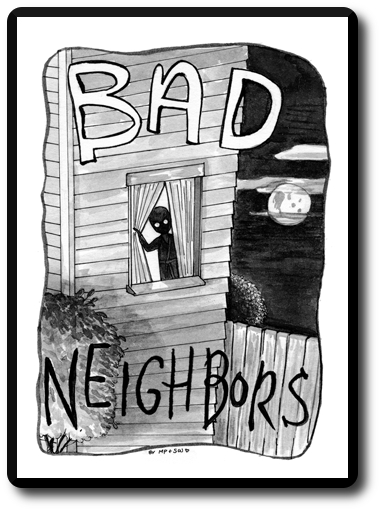
The Basics:
- For ages 12 and up
- For 2 to 5 players
- Approximately 15 minutes to complete
Geek Skills:
- Active Listening & Communication
- Logical & Critical Decision Making
- Reading
- Pattern Matching
- Hand/Resource Management
Learning Curve:
- Child ? Not Tested (presumed ?Easy?)
- Adult ? Easy
Theme & Narrative:
- Survive the perils of living in one very messed up neighborhood
Endorsements:
- Gamer Geek rejected!
- Parent Geek mixed!
- Child Geek untested!
Overview
It was bound to happen. When the Zombie-Alien-Demon-Vampire Apocalypse erupted, your family was prepared for the worst. What you didn?t count on, ironically, was your neighborhood. The biggest threat is not the giant undead half-demon munching on your grandmother. Rather, it?s your neighbors who are quietly spying on you from behind closed curtains. This game is all about the survival of the fittest in the suburbs. Lock, load, and live!
Bad Neighbors, designed by?Michael Peterson and?Sunday Williams and published by?Cuddle Manor, is comprised of 20 Monster cards, 16 Weapon cards, 8 Action cards, and 26 Family Member cards, and 1 blank Family Member card for you to customize. The artwork on the cards visibly nods and pays homage to various Pop and Geek Culture characters. For example, ?Creepy School Girl? is based on of?Samara Morgan from the horror movie?The Ring (or?Sadako from?Ringu, if you want to be technically correct), ?Junior? the zombie baby from the movie Braindead?(later retitled?Dead-Alive), and even?Edward from the?Twilight movie series. But not only movies are represented. Video game references and D&D references abound, too. And while the illustrations on the cards are very well done, they are not altogether ?family friendly?. Parents are highly encouraged to take a look at the game before putting it in front of their children. For example, here are three of the most disturbing cards, according to our Parent Geeks. We?ll leave it up to you to determine if they are appropriate or not, but to be fair, the game designers did tell us that they didn?t think the game was meant for younger Child Geeks.
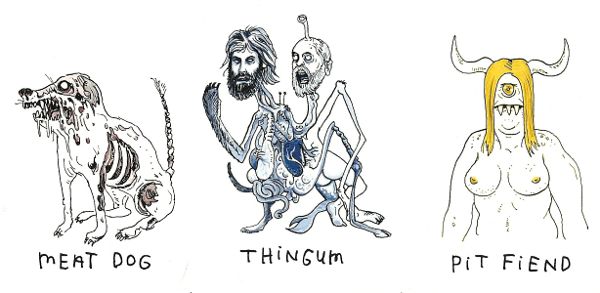
Game Set Up
To set up the game, first separate the cards into two different decks. The backs of the cards are different for each deck, making this step an easy exercise. When completed, there should now be two different decks. The first, and the largest, will be comprised of Monster, Weapons, and Action cards. The back of this deck shows the title of the game. The second deck will be comprised of Family Member cards. The back of this deck shows a headstone.
Second, deal out to each player 4 Family Members cards. There is no need to shuffle this deck prior to doing so. The Family Member cards are placed face-up in front of their owning players in a single row. Place any unused Family Member cards aside as they are not used for the duration of the game.
Third, shuffle the other deck and deal out to each player 4 cards. Players should keep these cards hidden from their opponents at all times. Place the remaining deck face-down in the middle of the playing area and leave room for a discard pile beside it. This deck is now referred to as the ?draw deck?.
That?s it for game set up. Traditionally the player with the ?Wade? Family Member card goes first. If ?Wade? is not present, the first player should be the player directly to the left of the dealer.
There Goes the Neighborhood
The game is played in turns with no set number of turns per game. A player?s turn is summarized here.
Step 1: Play a Card?or Don?t
The player could have up to 3 different card types in their hand. These are Monster, Weapon, and Action cards. Monster cards represent four different groups (or suits) of nasties. These are Vampires, Zombies, Aliens, and Demons. Each group has an icon that identifies its ?suit?. If a player has a Monster card, they must play it to the table if there is at least one opponent who can be attacked by it. And by ?attacked?, I mean the opponent?s Family Members have no visible way of defending themselves. When playing a Monster card, the player places it next to the opponent they are attacking.
At this point, the opponent can now block the attack by playing a Weapon card from their hand. Each Weapon card has an image of one of the four suits, but with an ?X? through it, signifying it cancels that specific suit. If the opponent has a Weapon card that cancels the Monster card, they play it from their hand now and place it on one of their Family Member cards that DO NOT have a Weapon card already attached. Optionally, the opponent could play a Weapon card on a Family Member who already has a Weapon card. If they do, the new Weapon card replaces the old, sending the other Weapon card to the discard pile. The Monster card is then discarded and the player goes to step 2.
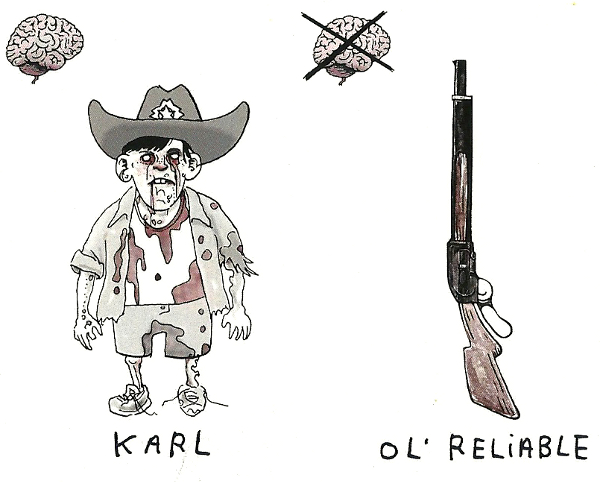
If the opponent does not have a Weapon card that can cancel the Monster card attack, the opponent selects one of their Family Members (preferably one that does not have a weapon) and flips it over to the other side to show ?the headstone (signifying the Family Member is now 6 feet under). If the Family Member that is selected by the opponent has a Weapon card attached, the Weapon card is placed in the discard pile when the Family Member card is flipped over. Regardless of the outcome, the Monster card is placed in the discard pile and the player goes to step 2.
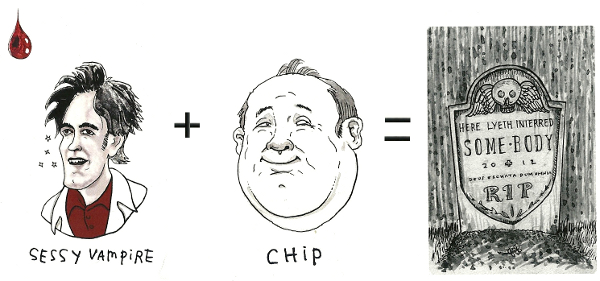
If a player does not have a Monster card, they can play an Action card if they like or simply discard any one card from their hand. If the player plays an Action card, they read it out loud to the table and the effects of the Action card are resolved. Some of the Action cards depend a great deal on timing. For example, a few can only be played as reactions towards other attacks and one Action card, ?Pet Cemetery?, is only useful when the player has at least 1 Family Member who has died.
Step 2: Draw Cards
The player now draws back up to 4 cards taking as many cards as necessary from the top of the draw deck. If there are no more cards in the draw deck, shuffle the discard pile and create a new draw deck.
This completes the player?s turn. The next player going clockwise now goes.
Survival and Victory
The game continues as described above until one of the two following victory conditions are met.
- The first player to play 1 Weapon card from each of the 4 suits wins the game. Note that a player can only place a Weapon card on a Family Member card when they are attacked by the specific Monster type the Weapon card counters. Additionally, a Family Member can only have 1 Weapon card attached to them at a time. If a Family Member is ever stolen by an opponent, the Weapon card goes with them.
- The last player with living Family Members wins the game.
To learn more about?Bad Neighbors, visit the game?s web site.
Prediction
I?ll be the first to suggest that there isn?t much to?Bad Neighbors, but I don?t think for a moment it was ever intending to be anything other than a fast and silly card game. The artwork on a number of the cards makes it impossible for me to share it with my own Child Geeks, however, and I am fairly certain the other Parent Geeks I will be playing the game with will feel the same way. The Zombies are horrific and there is a naked big breasted, one-eyed she-demon that is strangely alluring in a creepy kind of way. Most of the time, I?d just remove the offending cards, but in the case of?Bad Neighbors, doing so would actually break the game.
Going forward with the assumption that the Child Geeks will not be enjoying this game at the gaming table anytime soon, that leaves us with only the Parent Geeks and the Gamer Geeks to play?Bad Neighbors with.
For the Parent Geeks, I think this game is going to be a solid hit or a dreadful miss. The game depends a great deal on the player having a sense of humor and being ?in the know? when it comes to Pop and Geek Culture. If the Parent Geeks we play the game with are not amused by the game, it will fail. If the Parent Geek is amused and gets a few smiles, they might warm up to it. Ultimately, it?s the mood at the gaming table that is going to determine if the game is worthwhile. If the majority of players aren?t having a good time, they?ll blame it on the game?and me.
I think the Gamer Geeks are going to dislike this game vehemently and their level of criticism will be palatable. There is nothing to suggest in the rules that the game play will appeal to the Gamer Geeks. So strongly do I believe this that I am considering not sharing?Bad Neighbors with the Gamer Geeks at all. I don?t want to waste the Gamer Geeks? time, nor did I want to throw the game under the proverbial bus. But you know I?m going to anyway. A review is worthless if you don?t test the game in front of different groups.
Teaching and learning how to play?Bad Neighbors?will not take anyone long. In fact, the summarized rules of play are printed on the sides of the card box. What is detailed there is pretty much all you need to know in two steps. The most frequent question I was asked after going through the game rules was, ?Is that It??
I, for one, am very curious to see how this is going to play out?
Final Word
As predicted, none of the Parent Geeks wanted to share the game with their children. For this review, we cannot suggest that?Bad Neighbors is or is not appropriate for your children or even if Child Geeks would enjoy the game. We?ll leave it up to you, the Parent Geeks, to reach your own conclusions.
For the Parent Geeks, it went down exactly as I predicted. If the Parent Geek was amused by the illustrations and the sometimes not-to-subtle Geek Culture references, they thought the card game was funny. For those Parent Geeks who didn?t, they spent most of the time wondering why some of their peers were laughing. All the Parent Geeks thought the game was ?OK? at best, and for some Parent Geeks, that was a stretch. According to one Parent Geek who wanted to be quoted, ?This is obviously a game that was created by someone who loved their own idea and this is the result.? I believe they were suggesting that?Bad Neighbors is a product of passion, where the game designers created a game they wanted to play and enjoy with their friends. If such is the case, I totally agree with the Parent Geek. In the end, the overall endorsement for the game was very mixed. Some thought it would be good for light game nights with their peers and some thought the game would make for a good chew toy for their pets.
Also, as predicted, the Gamer Geeks tore?Bad Neighbors a new one. Oh, lordy, how they disliked it. I was constantly asked why I bothered to put the game in front of them and the colorful words of criticism spilled out from the group from start to finish. Some of the Gamer Geeks even cheered on some of their peers to ?quickly end the game so we can play something else?. I encouraged them to keep the game in perspective and just play it for what it was. When we were done, none of the Gamer Geeks thought highly of the game. Pretty sure they started to think less of me, too. According to one Gamer Geek, ?Bad Neighbors? More like Bad Game, if you ask me.? Another Gamer Geek summed up his opinion on the game by simply saying, ?Sucks?. And finally, another Gamer Geek said, ?Awful. The only thing I liked about it was that a card used my name.? Ouch. Clearly,?Bad Neighbors left a very bitter taste in the Gamer Geeks? collective mouths. When the game was picked up and put away, everyone agreed never to speak of?Bad Neighbors again except in a context that somehow belittled me.
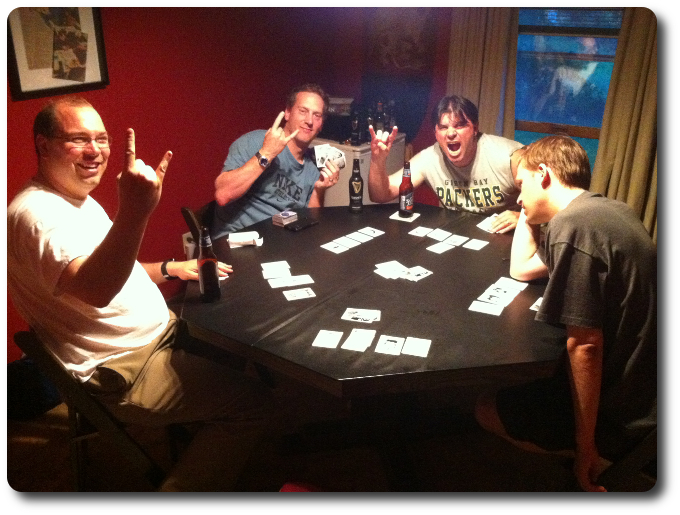
The ?joy? you see is fake ? I told them to ?smile? for the camera ? one Gamer Geek ignored me
Bad Neighbors is most certainly going to be a niche game. I was unable to observe any game play that would suggest that Bad Neighbors?would have broad appeal in the general sense. It?s downright brave to introduce such a game to other players who know nothing of the game?s history. Especially when the game in question has most likely been tailored to a specific group. I commend the game designers for passing us their game and letting others play it. By doing so, they opened it up to harsh criticism, which it received in abundance.
Personally, I don?t care for the game. I find it to be too light and repetitive. The meaningful actions I can take are exceedingly small in number and there is nothing in the way of strategy to be had. It?s a game I could play half-awake and that does not appeal to me. The games I enjoy are far more complex, deep in game play, and leave me feeling like I worked for a victory.?Bad Neighbors leaves me with none of this. It?s not the type of game I would seek out or wish to play when there is so much else out there. If the game was appropriate for my little geeks, I?d be singing a different tune. Playing games this light is only fun when I can play with my kids. As it is now, I can only play it with sarcastic passive-aggressive Gamer Geeks and highly unamused Parent Geeks.
For every player there is a game, and for every game there is a player. I was unable to find a solid match, but perhaps you can. If the game?s theme and easy play appeals to you, I encourage you to look into it. It could just be the perfect ?light card game filler? you?ve been looking for.
This game was given to Father Geek as a review copy. Father Geek was not paid, bribed, wined, dined, or threatened in vain hopes of influencing this review. Such is the statuesque and legendary integrity of Father Geek.
Source: http://fathergeek.com/bad-neighbors/
2013 NFL Mock Draft paleo diet paleo diet earth day Luis Suarez Earth Day 2013 westboro baptist church
No comments:
Post a Comment
Note: Only a member of this blog may post a comment.